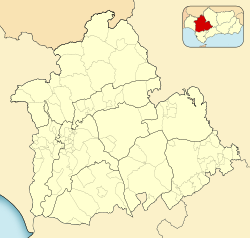Santiponce | |
|---|---|
 | |
| Coordinates: 37°26′7″N6°2′36″W / 37.43528°N 6.04333°W | |
| Country | |
| Autonomous community | |
| Province | Seville |
| Comarca | Aljarafe |
| Judicial district | Santiponce |
| Government | |
| • Mayor | Carolina Casanova Román (PSOE-A) |
| Area | |
• Total | 8.38 km2 (3.24 sq mi) |
| Elevation | 18 m (59 ft) |
| Population (2018) [1] | |
• Total | 8,442 |
| • Density | 1,000/km2 (2,600/sq mi) |
| Demonym | Poncino |
| Time zone | UTC+1 (CET) |
| • Summer (DST) | UTC+2 (CEST) |
| Postal code | 41970 |
| Official language(s) | Spanish |
Santiponce is a town located in the province of Seville, Spain. According to the 2006 census (INE), the town has a population of 7742 inhabitants. [2]
The town contains the ruins of the Roman city Italica.




